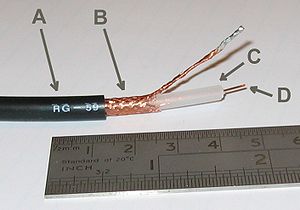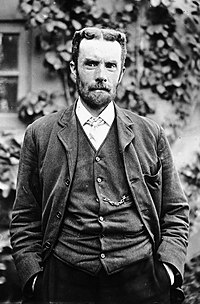Coaxial cable
The coaxial cable, coax, coaxcable or coax, is a cable used to transport electrical signals from high frequency that has two concentric conductors, a central one, called the core, in charge of carrying information, and an outer one, with a tubular appearance, called a mesh, shield or braid, which serves as a ground reference and current return. Between the two there is a dielectric insulating layer, the quality of the cable will depend mainly on its characteristics. The entire assembly is usually protected by an insulating cover (also called an outer jacket).
Coaxial cable was used in the first transatlantic telegraph cables beginning in 1858, but its theory was not described until 1880 by the English mathematician and electrical engineer Oliver Heaviside, who patented his design that same year.
Description
The central conductor can be made up of a solid wire or several twisted copper wires; while the exterior can be a braided mesh, a rolled sheet or a corrugated tube of copper or aluminum. In the latter case, a semi-rigid cable will result.
Due to the need to handle increasingly higher frequencies and the digitization of transmissions, in recent years the use of coaxial cable has gradually been replaced by fiber optic cable, particularly for distances greater than several kilometers, because the bandwidth of the latter is much higher.
The choice of design affects the size, flexibility, and electrical properties of the cable. A coaxial cable consists of a copper wire core surrounded by an insulator (or dielectric), a metal braid shield or shield, and an outer jacket.
The core of a coaxial cable carries electronic signals that make up information. This core can be solid (usually copper) or wire. Surrounding the core there is a dielectric insulating layer that separates it from the wire mesh. The braided wire mesh acts as a ground, protecting the core from electrical noise and distortion from adjacent wires. The core and mesh must be separated from each other. If they were to touch, a short circuit would occur, and the noise or signals that are lost in the mesh would go through the copper wire.
Shielding refers to the braiding or mesh of metal (or other material) that surrounds the wires. The shielding protects the data that is transmitted, absorbing the noise, so that it does not pass through the cable and there is no data distortion. Cable that contains an insulating foil and a metal braid shield layer is called a double shielded cable. For large interferences, there is quadruple shielding. This shielding consists of two insulating sheets, and two layers of metal braided shielding.
A short circuit occurs when two wires or a wire and a ground come into contact. This contact causes a direct flow of current (or data) in an unwanted path. In the case of a common electrical installation, a short circuit will cause a spark and blow the fuse or circuit breaker. With electronic devices that use low voltages, the effect is less, and almost undetected. These low voltage short circuits cause the device to fail and the data that was being transferred is usually lost.
A non-conductive outer jacket (usually made of rubber, Teflon, or plastic) surrounds the entire cable to prevent potential electrical shock.
Coaxial cable is more resistant to interference and attenuation than twisted pair cable; for this reason there was a time when it was the most used.
The wire mesh absorbs stray electronic signals so they don't affect data sent over the internal cable. For this reason, coaxial cable is a good choice for long distances and for reliably supporting large amounts of data in a simple system.
In coaxial cables, the fields due to the currents that flow through the internal and external cables cancel each other out.
Features
The main feature of the RG-58 family is the central copper core. The following types are considered:
- RG-58/U: solid copper core.
- RG-58 A/U: core of braided threads.
- RG-59: Broadband transmission (CATV).
- RG-6: greater diameter than the RG-59 and considered for frequencies higher than this, but also used for broadband transmissions.
- RG-62: ARCnet networks.
Types of coaxial cable (standards)
Most coaxial cables have a characteristic impedance of 50, 52, 75, or 93 ohms, with 75 being the most common. The RF industry uses standard type names for coaxial cables. In television connections (by cable, satellite or antenna), RG-6 cables are the most commonly used for use in the home, and most connections outside of Europe are by F connectors.
Here we show some tables with the characteristics:
| Type | Impedance [Ω] | Nucleus | Dieléctrico | Diameter | Trained | Speed | |||
|---|---|---|---|---|---|---|---|---|---|
| [in] | [mm] | [in] | [mm] | ||||||
| RG-6/U | 75 | 1.0 mm | Solid PE | 0.185 | 4.7 | 0.332 | 8.4 | double | 0.75 |
| RG-6/UQ | 75 | Solid PE | 0.298 | 7.62 | |||||
| RG-8/U | 50 | 2.17 mm | Solid PE | 0.285 | 7.2 | 0.405 | 10.3 | ||
| RG-9/U | 51 | Solid PE | 0.420 | 10.7 | |||||
| RG-11/U | 75 | 1.63 mm | Solid PE | 0.285 | 7.2 | 0.412 | 10.5 | 0.66 | |
| RG-58 | 50 | 0.9 mm | Solid PE | 0.116 | 2.9 | 0.195 | 5.0 | Simple. | 0.66 |
| RG-59 | 75 | 0.81 mm | Solid PE | 0.146 | 3.7 | 0.242 | 6.1 | Simple. | 0.66 |
| RG-62/U | 92 | Solid PE | 0.242 | 6.1 | Simple. | 0.84 | |||
| RG-62A | 93 | ASP | 0.242 | 6.1 | Simple. | ||||
| RG-174/U | 50 | 0.48 mm | Solid PE | 0.100 | 2.5 | 0.100 | 2.55 | Simple. | |
| RG-178/U | 50 | 7x0.1 mm Ag pltd Cu clad Steel | PTFE | 0.033 | 0.84 | 0.071 | 1.8 | Simple. | 0.69 |
| RG-179/U | 75 | 7x0.1 mm Ag pltd Cu | PTFE | 0.063 | 1.6 | 0.098 | 2.5 | Simple. | 0.67 |
| RG-213/U | 50 | 7x0.0296 in Cu | Solid PE | 0.285 | 7.2 | 0.405 | 10.3 | Simple. | 0.66 |
| RG-214/U | 50 | 7x0.0296 in | PTFE | 0.285 | 7.2 | 0.425 | 10.8 | double | 0.66 |
| RG-218 | 50 | 0.195 in Cu | Solid PE | 0.660 (0.680?) | 16.76 (17.27) | 0.870 | 22 | Simple. | 0.66 |
| RG-223 | 50 | 2.74mm | PE Foam | .285 | 7.24 | .405 | 5.4 | double | |
| RG-316/U | 50 | 7x0.0067 in | PTFE | 0.060 | 1.5 | 0.102 | 2.6 | Simple. | |
- PE = polyethylene.
- PTFE = polytetrafluoroethylene.
- ASP = polyethylene air space.
Trade names
| Type | Impedance [Ω] | Nucleus | Dieléctrico | Diameter | Trained | Speed | |||
|---|---|---|---|---|---|---|---|---|---|
| type | [in] | [mm] | [in] | [mm] | |||||
| H155 | 50 | 0.79 | |||||||
| H500 | 50 | 0.82 | |||||||
| LMR-100 | 50 | 0.46 mm Cu | PE | ||||||
| LMR-195 | 50 | 0.94 mm Cu | PE | 0.194 | 4.928 | ||||
| LMR-200 HDF-200 CFD-200 | 50 | 1.12 mm | PF CF | 0.116 | 2.95 | 0.195 | 4.95 | 0.83 | |
| LMR-240 | 50 | 1.42 mm | PF | 0.24 | 6.096 | ||||
| LMR-400 HDF-400 CFD-400 | 50 | 2.74 mm Cu and Al | PF CF | 0.285 | 7.24 | 0.405 | 10.29 | 0.85 | |
| LMR-600 | 50 | 4.47 mm Cu and Al | PF | 0.455 | 11.56 | 0.590 | 14.99 | 0.87 | |
| LMR-900 | 50 | 6.65 mm BC tube | PF | 0.680 | 17.27 | 0.870 | 22.10 | 0.87 | |
| LMR-1200 | 50 | 8.86 mm BC tube | PF | 0.920 | 23.37 | 1,200 | 30.48 | 0.88 | |
| LMR-1700 | 50 | 13.39 mm BC tube | PF | 1.350 | 34.29 | 1.670 | 42.42 | 0.89 | |
Types
There are multiple types of coaxial cable, each with a different diameter and impedance. Coaxial cable is usually not affected by external interference, and is capable of high data transmission speeds over long distances. For that reason, it is used in broadband communication networks (CATV) and baseband cables (Ethernet).
The type of cable to use depends on the location of the cable. Coaxial cables can be of two types:
Polyvinyl chloride (PVC)
Polyvinyl chloride is a type of plastic used to construct the insulation and protective cable jacket on most types of coaxial cable. PVC coaxial cable is flexible and can be easily installed anywhere. However, when it burns, it gives off toxic gases. It is more prone to corrosion damage outdoors; for this, polyethylene covers are used.
Plenium
The plenum contains special materials in its insulation and in a cable pin. These materials are fire resistant and produce a minimal amount of toxic fumes.
Technological applications
You can find a coaxial cable:
- Between the antenna and the television;
- in urban networks of cable television and the Internet;
- between a radio station and its emission antenna (radio teams);
- in the video signal distribution lines (the RG-59 is usually used);
- in data transmission networks such as Ethernet in its old 10BASE2 and 10BASE5 versions;
- on interurban telephone networks and on submarine cables.
Before the massive use of optical fiber in telecommunications networks, both terrestrial and submarine, coaxial cable was widely used in analog telephone transmission systems based on frequency division multiplexing (FDM), where they reached transmission capacities of more than 10,000 voice circuits. Likewise, in digital transmission systems, based on time division multiplexing (TDM), the transmission of more than 7000 128 kbps channels was achieved.
The cable used for these long-distance transmission purposes needed to have a different structure to that used in local network applications, since, because it was installed buried, it had to be protected against tensile and pressure stresses, therefore which normally, apart from the corresponding insulators, had an external steel reinforcement.
Loaded twisted pair – It is a twisted pair to which inductance is intentionally added, which is quite common in telecommunication lines, although at certain frequencies there are exceptions. These added inductors are known as Pupin coils and they reduce distortion.
Bonded twisted pair – It is a variant of the twisted pair cable, where the pairs are joined individually, making the cable more robust. The electrical specifications for the cable remain the same, despite the rough handling.
Twisted Ribbon Cable – A variation on the standard ribbon cable, in which adjacent conductors are used, which are slaved and twisted. Regarding the twisted pairs, it is noted that they are slightly slaves to each other with a tape format. Periodically, as the ribbon is progressed, small sections will be provided where there is no braid to ensure that the printed circuit headers and connectors are terminated with usual techniques for an IDC ribbon cable.
Contenido relacionado
Friend-foe identifier
System V
Wind power



